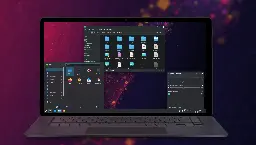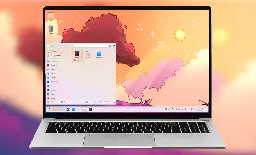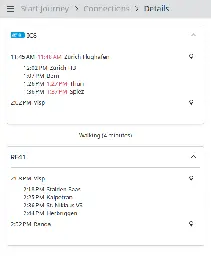Because it's not actually a good idea.
You create text that is basically impossible to search. Like, for instance, do a Ctrl+F on this page and search for "Bold". You'll see the example from OP doesn't get picked up, because it's not a B, it's a 𝗕. And it's not an o, it's an 𝗼. And so on. Or how about this? Go on Google and copy-paste this word from OP: "s̵t̵r̵o̵k̵e̵". Now, stroke isn't a particularly unusual word, but this thread is just about the only result Google returns. Because it's not stroke. It's s̵t̵r̵o̵k̵e̵.
It's also bad for accessibility. A lot of the time screen readers just won't know what to do with your bold or italic Unicode text.
And of course this only works for characters for which Unicode actually has these variants. Not a problem with the Latin alphabet, but what about Arabic? Cyrillic? Chinese? Devanagari? Hangul? Not gonna work.
These characters are from the Mathematical Alphanumeric Symbols code block. They're stylized Greek and Latin letters meant chiefly for use in mathematical contexts. The Unicode standard explicitly advises against using them to fake markup for the reasons outlined above and more. A simple markup language is just about always going to be preferable to faking it with Unicode.
Source? Last I checked, the Steam Deck was very much in the minority even when narrowed down to just desktop Linux.
Yeah. xwayland isn't gonna die ever probably, so there's no rush.
like most apps on Linux, kde connect was never exclusive to any desktop. you don't need gsconnect.
At the moment, we have Blink (Chrome), Gecko (Firefox), Webkit (Safari), Servo, Ladybird and Goanna (Pale Moon).
At best, another Pale Moon is what would happen. They've been maintaining their own hard fork of Gecko by themselves since 2016. They clearly have people capable of maintaining a browser engine, though perhaps not quite enough of them. If Firefox were to die, perhaps joining up with Goanna would be the smart move.
There are significantly fewer Firefox-based browsers than there are Chromium-based ones, unfortunately. Out of the ones we do have:
Floorp has much like Vivaldi gone the proprietary source-available route, so you couldn't pay me to use it.
Pale Moon is easily the most involved of the Firefox forks, being a fork of a much older version of Firefox, but I wouldn't generally recommend it for security reasons. It does have its uses, though. Waterfox Classic is in a somewhat similar boat. Security-wise Pale Moon is definitely the better of the two because it uses its own fork of Gecko which is maintained about as well as you could reasonably expect given the manpower available to the project. Waterfox Classic meanwhile has kinda just been left to rot since most development is going to regular Waterfox nowadays, so it's not maintained nearly as well as Pale Moon and it's just been collecting CVEs. But for those same reasons if all you want is the ability to use legacy XUL extensions, then Waterfox Classic is gonna have better compatibility since it hasn't been modified nearly as heavily as Pale Moon.
LibreWolf is probably the most popular Firefox fork nowadays, but it isn't much more than a Firefox equivalent to Ungoogled Chromium. Waterfox goes a little further, but not by much. Both can be good choices, but personally I haven't had much reason to switch away from upstream Firefox. LibreWolf is tempting, but I can already disable pretty much all of the Firefox BS from about:config, so I don't see the point. It's pretty much just better defaults.
It is significantly less powerful when compared to LibreOffice, lacking support for many features. It offers less applications than LibreOffice. It is significantly less customizable than LibreOffice. It's built on bloated web tech. It lacks RTL support.
I am not paranoid about OnlyOffice's origin. I also do not think it is the best office suite on Linux by a mile.
The Steam Deck works well if you have a particularly twisted definition of "working well". SteamOS is certainly among the worst Linux distros I've used. It is certainly significantly worse than the average desktop-oriented distro. Sure, Valve has done good work with Proton, but basically every other piece of their stack is broken in some way.
Just a couple of days ago I had an issue where after the battery died and I plugged my Steam Deck into the charger, it simply failed to turn on. The fans would start spinning and that's it. Nothing else worked. I could not get into the BIOS menu. I could not get into the recovery menu. The solution? Unplug the Deck, let the battery die from spinning fans and plug it back in, hoping that time it'll turn on. Spinning fans take a long time to drain the battery, so this took me a couple of hours even though I'd only been plugged in for about ten minutes. I am not the first to deal with this issue. You can see posts online about it more than a year old. Those posts are how I was even able to figure out the solution.
I will never understand why SteamOS gets any kind of praise. This kind of issue is unacceptable. Any non-tech-savvy user will assume their device got bricked. I've seen several people mention they did RMA over this. And despite being a critical failure known for over a year, it hasn't been fixed.
If you're not a techy, SteamOS is garbage. It is ridiculously unpolished and keeps breaking in ways that can be difficult to fix. Every update (especially the client updates) has a 50/50 chance of breaking something, even on the stable update channel. You have to switch to desktop mode just to use a web browser. In fact, you have the switch to desktop mode for a lot of things, because gaming mode doesn't let you do things like adding non-Steam games, install Flatpak applications or use a file manager. But desktop mode is entirely unsuited for gamepad controls and the on-screen keyboard feels particularly sluggish (though it can also get sluggish in gaming mode, just not as often).
If you're a techy, SteamOS is also garbage. It is still ridiculously unpolished and the immutability is implemented in such a way that completely neuters the whole OS as anything you change gets wiped on every update (you can't layer). There are hacks to do most things from gaming mode. You can run Firefox with some kind of weird setup where you run it inside a nested KWin session, because Gamescope is completely incapable of handling multiple windows, which would normally break all of the context menus and the hamburger menu in Firefox. Similar deal with Dolphin for file management. You can even run the entire Plasma desktop nested inside Gamescope, albeit with some caveats. Still need to switch to Desktop Mode to add non-Steam games tho, since you can't run the desktop Steam Client from Nested Desktop. Things break occasionally, but it's manageable. Figuring out all of these workarounds is quite time consuming though. This would not be the case if SteamOS was actually a good distro.
Would need a decent port of JDK to RISC-V.
Is there any reason you need to switch other than the age of the last releases? Avidemux had its last release in 2022 and its last commit a week ago. For a piece of software with a fairly stable and unchanging set of features, that seems pretty reasonable to me. Avidemux still works fine on Linux and is still packaged by all of the large Linux distros, so I don't see the problem. VirtualDub's definitely dead, though.
IIRC the Krita people were working on redoing the text tool. Not sure if/when it's going to be finished, though.
Holy shit, will people ever shut up about the name? The truth is that barely anyone actually gives a shit except FOSS zealots trying to come up with excuses for why GIMP wasn't successful (or those belonging to the anti-GIMP circlejerk that's surfaced as of late trying to come up with new nonsensical reasons to hate a random piece of FOSS). Outside of the English-speaking world, the amount of people who give a shit about GIMP's name is precisely zero and the word gimp is almost exclusively associated with the program. Even inside of the English-speaking world, I see GIMP used to refer to the program more often than for anything else. The amount of people actually who actually care about the name is negligible and the amount of brand recognition that would be lost from a rename would significantly outweigh the benefits of possibly having a couple more schools think about maybe starting to use GIMP.
And the truth is that as far as FOSS GUI programs are concerned, GIMP has been tremendously successful. It's easily among the most popular, alongside Blender, Firefox and LibreOffice. It is and always has been far more popular than Krita in both professional and non-professional contexts. I've seen it installed on the computers of both my secondary school and college, because it turns out school computer labs need image editors and they're not going to pay for Photoshop licenses.
But it hasn't been more successful than Photoshop. And Firefox hasn't been more successful than Chrome. And LibreOffice hasn't been more successful than MS Office. And Blender hasn't been more successful than Maya. And Godot hasn't been more successful than Unity. And I could go on. Because no single FOSS GUI program has achieved industry standard status. Though Blender has a pretty good shot at making it.
Why would Adobe do literally anything about CS6 in the year 2024 when they discontinued in 2013?
Nah, a ton of Linux fans seem to shill hard for Apple for some reason.
Oh boy, Davinci? Don't hold your breath, it's super picky even with the more mature GPU drivers.
Content blockers like uBlock use filter lists which list every single element that needs to be blocked across the entire web. I currently have nearly 700000 of these filters active. That is very far outside the scope of a simple script. Basically all ad blocking userscripts are site-specific and they still usually block significantly less than uBlock would on the same site. Also, userscripts are not safer than extensions.
Most AUR packages that aren't postfixed with "-bin" are compiled on your system. Most distro packages have AUR counterparts, but they're usually git builds, so using them for every package you can will probably just break your system.
It's not an unpopular opinion that Apple is the only one that does sleep right. It is an unpopular opinion that this is only possible because they have a complete walled garden and that open platforms are fucked, especially considering it is easy and common to install applications from outside the App Store on macOS. We used to have sleep figured out, that's what S3 was. But then hardware vendors dropped it. So yes, drivers and hardware vendors are part of the problem. The Steam Deck is an example of an open platform where sleep works fine.
Hey everyone! Here is a new video explanation of the changes we have done. This time we tackled Labplot, maps, and media icons! Can you believe it? We are now officially past the mid-way for the ic…

Hi everyone, long time user, first time releaser here. I am happy to announce the immediate availability of Amarok 3.0 beta (2.9.82)! This is the next step towards a proper KF5 based release. Although there have been some functionalities lost during porting or due to changes in external network s...

Amarok might be coming back in 2024
Amarok was KDE's flagship music player during the KDE3 and Plasma 4 days. For Plasma 5, a new music player called Elisa was created with Kirigami which is the current KDE flagship music player. The last full release of Amarok was 2.9.0 in 2018, still targeting Qt4. A Plasma 5 port was started with the intention of being released as Amarok 3.0, but despite a usable alpha 2.9.71 release in 2021, the full 3.0 release was never completed. Outside of the occasional odd pull request, the project was essentially dead and was listed as unmaintained by apps.kde.org.
Two weeks ago, occasional contributor Tuomas Nurmi, author of over a third of these pull requests, made a push to become an Amarok maintainer, starting this thread in the mailing list: https://mail.kde.org/pipermail/amarok-devel/2024-March/014748.html
In the thread, Tuomas expresses his desire to revive Amarok. He believes a second alpha for 3.0 can be released in mid-April and a full Plasma 6 port could be completed within 2024 after the release of 3.0. Tuomas has since created a fair amount of merges and fixes in preparation for 3.0 and has shown no sign of stopping.
This is very exciting news. For many, Elisa isn't a satisfying replacement for Amarok. It simply doesn't come close to matching Amarok's power and features. It also has the drawback of being a convergent application, meaning compromises have to be made to make the interface work well on smartphones.
It's also victim to the many drawbacks of Kirigami. Theming is worse since Plasma has to convert QtWidget themes to QtQuick themes, which works great for Breeze, but meh for everything else. There is no good equivalent for KStandardAction/QAction, KHamburgerMenu or KStandardShortcut. Any Kirigami app that wants customizable toolbars and shortcuts need to go out of their way to implement them, while QtWidgets apps just get them for free. You also don't have a good QDockWidget equivalent that I know of. Apps that do bother to reimplement some of these features (Haruna is the only one I know of) still don't have toolbar customization to nearly the same extent QtWidgets apps do. Most Kirigami apps don't bother with this at all and lose a lot of customizability in the process. Elisa is not Haruna, tho. There is no shortcut customization, there is no toolbar to customize and that hamburger menu can't be turned into a menubar.
For years, the solution was Strawberry, a fork of Amarok still under active development. Thing is, Strawberry is a fork of Clementine, itself a fork of Amarok 1.4. That's old. That's 2008 Amarok, not 2018 Amarok. Clementine had its first release in 2010, when Amarok was still going strong. It was for good reason, Amarok 2.0 introduced a very divisive redesign of the interface, which prompted a fork. But this means 2.0+ Amarok and Strawberry are actually very different beasts. For those who were using Amarok 2.9, switching to Strawberry meant switching to a new music player, making it far from an ideal successor. So I'm very much excited for the return of Amarok, the best music player KDE has had.
Hi all, I am back with another update for adapting icons to the 24px grid and doing some larger edits. This week, I worked on 3 rows, which is great, and was able to hit just past the 50% mark, it …
Today KDE releases a bugfix update to KDE Plasma 6.

Hey all, I have been away for a minute but wanted to give you an update on the work so far in updating and adapting Breeze icons to the 24px grid. Check out the video below.

Two weeks ago I showed a screenshot of initial support for the MOTIS routing engine in KTrip in my FOSDEM 2024 report. Driven by the Transitous work this is ...

Improving KdeEcoTest and making it compatible on Wayland systems

After a lot of work, we moved our website to a new Hugo based platform! A lot of time and energy went into making this new version.
We recently remove the Plucker/Palm support in Okular, because it was unmaintained and we didn't even find [m]any suitable file to test it. ...
Nothing! That’s the end of the blog post! Go back to what you were doing! Well, sort of. :) Some of you may be aware that a year or so ago, there was a lot of chatter about what to do with th…


